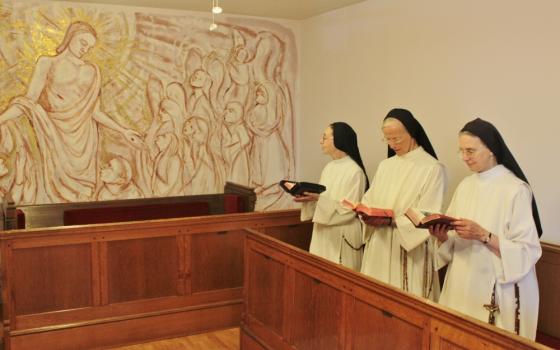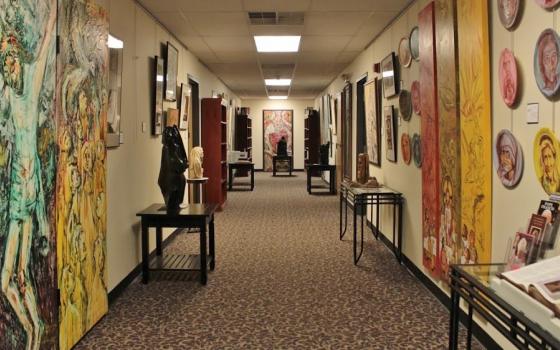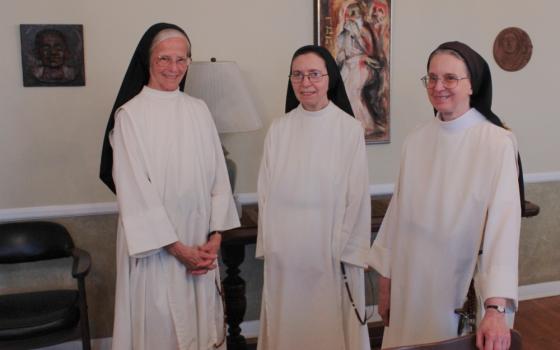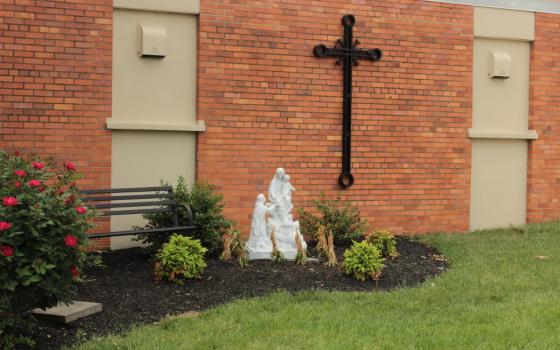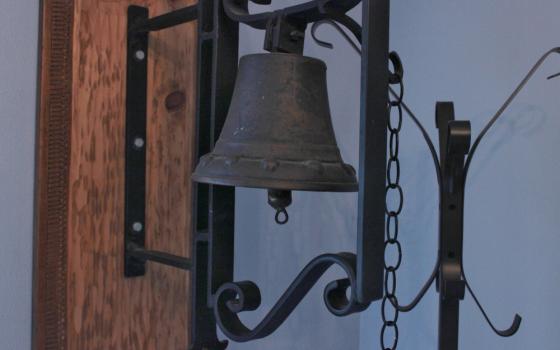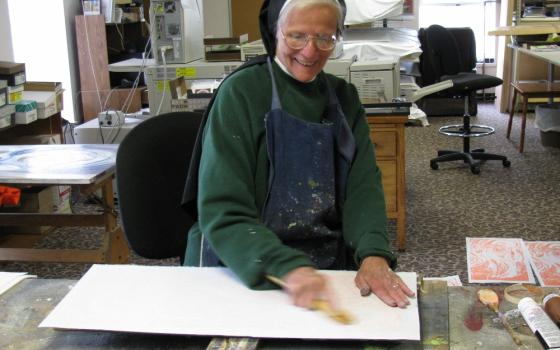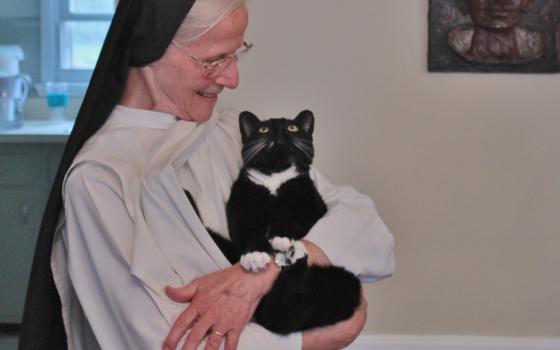For Dominicans, whether they be nuns, friars, brothers or sisters in active ministry, the whole is always greater than the sum of its parts. “The Dominicans are a family,” says Sr. Emmanuela, one of the three nuns who reside at Caterina Benincasa Monastery (named to honor the 14-century mystic Catherine of Siena) in New Castle, Delaware.
“We speak things over. We debate, so it’s very creative,” says her friend and colleague, Sr. Mary Columba, about life in a community that has navigated choppy waters to become an established part of a bustling urban landscape. “The end product isn’t helping the monastery survive until doomsday — it’s how we serve the mission.”
But the decision to launch a new community in New Castle in 2007 was not easy for Srs. Emmanuela, Mary Grace and Mary Columba, longtime friends now in their 70s and 80s. Though approved by church leaders, it was in some ways a step into unknown territory, attracting bewilderment from some and support from others.
The women draw deeply upon the traditional model of community and individual prayer, but their presence on a campus that also contains a parish church and a school inevitably gives them a more public presence than customary in many monasteries.
“They are a new type of contemplative,” says Br. Ignatius Perkins, who has spent more than 30 years consulting with monasteries. “They have a strong and prophetic vision of what is needed through the church, and while they [themselves] aren’t active, they can influence others.”
“The contemporary need [for contemplatives] is huge,” says Perkins, who is helping the New Castle nuns articulate a plan for renewal that emphasizes their strengths and deals with any outside concerns. “The goal is to make sure they are living the authentic Dominican life in light of the new evangelization annunciated clearly by Benedict XVI,” he adds.
Perkins pointed out that the community is consistent with the rules of the order — and approved by Fr. Carlos Aspiroz-Costa, head of the Dominicans.
A familiar sight on the urban campus just a few blocks back from a busy highway, the nuns also run a gallery/gift shop that highlights the work of Sr. Mary Grace, an artist skilled in media as diverse as soapstone carving, woodcuts and oil painting, and whose work has been displayed in multiple exhibits.
“We’re like the apostolic sisters in general, who have become more liberal in their interpretation of religious life,” says Sr. Mary Grace, even as she notes that younger women seem more drawn to a more traditional environment. “It seems to me that young people who feel called by God to give their lives want more structure, and we are not in the best position to attract new numbers.”
It is possible, she adds, that a woman of more mature years might find their model of monastic life appealing.
Sr. Mary Grace, who attended university before she entered monastic life at 27 in Cincinnati, says that though she initially struggled with monastic austerity and silence, and that her superiors might have considered her an “oddball,” she never doubted her vocation. It wasn’t long before she made a fast friend in Sr. Mary Columba, who had entered at 18 and helped her make a transition from secular to enclosed life more than four decades ago. “There were storms, but she helped me over them. She believed in my vocation,” she says.
At the same time, it’s clear, both from what Sr. Mary Grace says and leaves unsaid, that life in the Dominican communities in which she lived could sometimes reflect the tension between those (the majority) who wanted to preserve traditional practices and others, like herself and her two New Castle compatriots, who called for change consistent with the spirit of renewal that swept through the church during the heady days following the Second Vatican Council.
“It’s an ancient but ever new way of expressing [contemplative practice],” says Sr. Mary Columba.
“It was a juncture in the life of the church,” she adds. “Society was changing and the church at every step through the centuries has to adapt, respond to the needs of the time. God providentially makes that happen.”
While Sr. Mary Grace had long known she needed to express her calling through art, Sr. Mary Columba also had nurtured a dream: to live the hermetic life of a Carthusian, an order modeled on the spiritual practices and strict silence of ancient monasteries.
A year or so after the Cincinnati monastery closed and she and Sr. Mary Grace moved to Washington, D.C., Sr. Mary Columba made the decision: she was going to Italy to test her Carthusian vocation.
Though she eventually had to return to the United States for health reasons, she still looks upon that time as a gift. “That’s why I have a deep love of a life really set apart. As much as we are trying to make monastic life more accessible, it’s also a place for the hidden life.” (Reluctant to have her picture taken for this story, Sr. Mary Columba also does not have her biography on the monastery website.)
Upon her return, she says, she discovered that the monastery in Cincinnati had become an ecumenical retreat house. Returning there, she became part of its new incarnation, appreciating not only the rhythms of the liturgy but also the opportunity to live out Pope John Paul II’s encouragement to foster ecumenical dialogue in a monastic context.
When the former monastery was eventually sold, she says, she found herself in the Bronx at another Dominican monastery, where she once again met up with Sr. Mary Grace — and began discussing their vision for a new foundation in New Castle, not far from a community of brother friars. (The men have since closed their house.)
“Here we are a little more in touch with people, but still immersed in monastic life,” says Sr. Mary Columba. “I have a heart for both.”
After 40 years as a monastic in the Detroit area, Sr. Emmanuela encountered Srs. Mary Grace and then Mary Columba in the Bronx at a time when she felt as though her vision of monastic life was not shared by the majority of her sisters. “We began to talk about similar things, and then began to think of doing something different,” she says.
After gaining permission from their superiors, and finding a monastery in Elmira, N.Y., that would sponsor them, the nuns moved to Delaware.
“Now communities are expected to take responsibility for their own lives and making it [the monastery] what it should be,” says Sr. Emmanuela. Once nuns had been set apart from the rest of the Dominican family by the cloister. “That’s not right. Our voice needs to be heard in the Dominican community. “
The nuns refer to difficult conversations they have had with colleagues in other communities, but they had nothing but praise for the piety of their sisters in faith, even when they disagree.
Though some Dominican nuns practicing a stricter form of enclosure may have questioned the three sisters’ move to New Castle, where they inhabit a convent that formerly housed apostolic sisters, they have generally remained “kind and supportive,” says Sr. Mary Grace. That includes ordering their Christmas cards from the monastery gallery/gift shop, an effort by the nuns both to make the work of Sr. Mary Grace available to the public and raise money to support themselves.
Though she has had time and a designated place (including a studio in Washington, D.C.) to practice her craft in three previous monasteries, Sr. Mary Grace says that she feels much more at home in the New Castle community than she ever has felt previously. “I’m only one of three here, but all are important.”
The nuns’ daily routine of corporate prayer, study, shared meals, and time for personal devotion and work would not be out of place in a traditional monastery. During work time, Sr. Mary Grace adjourns to her studio, and Srs. Mary Columba and Emmanuela are currently working on translating a book, written by an Italian friar and friend, on the concept of hospitality in the Muslim, Christian and Jewish faith traditions.)
The nuns spend a total of roughly seven hours a day in individual and group devotions, Sr. Emmanuela notes. “That is the core of our life. Everything else we do is like a hobby.”
Building community and constructing a fabric for their life together includes time for the occasional movie, hospitality and Sunday Mass at the parish church on campus, she adds.
“Sr. Emmanuela is the study person,” says Sr. Mary Columba. “She sews and takes care of the library and the website. It’s very easy to keep us abreast and in the picture with the social network.”
Perkins takes a broad view of the challenges the three nuns have faced. While there is a natural instinct for self-preservation in monastic communities where the numbers of vocations have ebbed, he says, “I also ask the question: Do you want to focus on preventing death or promoting life? There’s always a need to focus on what the church is calling us to do.”
It is also, he says, a risk. But it is one that is viewed as an extension of the Dominican spirit, one which seems to prize a democratic willingness to discuss, debate, and even experiment for the sake of spreading the Gospel. “We need to be able to influence the rest of the family,” says Sr. Emmanuela.
Their presence on the parish campus, at Sunday Mass, in the gift shop, or at the local supermarket, is also an extension of a witness to the world that goes back 800 years. “We want to be visible, for them to know that this form of life exists, says Sr. Emmanuela, “and that all people are called to their own form of contemplative life.”
[Elizabeth Eisenstadt Evans is a religion columnist for Lancaster Newspapers, Inc., as well as a freelance writer.]
This is the fourth profile of a six-part series called Contemplative Communities.
Click here to see the introductory article and other profiles, as well as two related columns.
